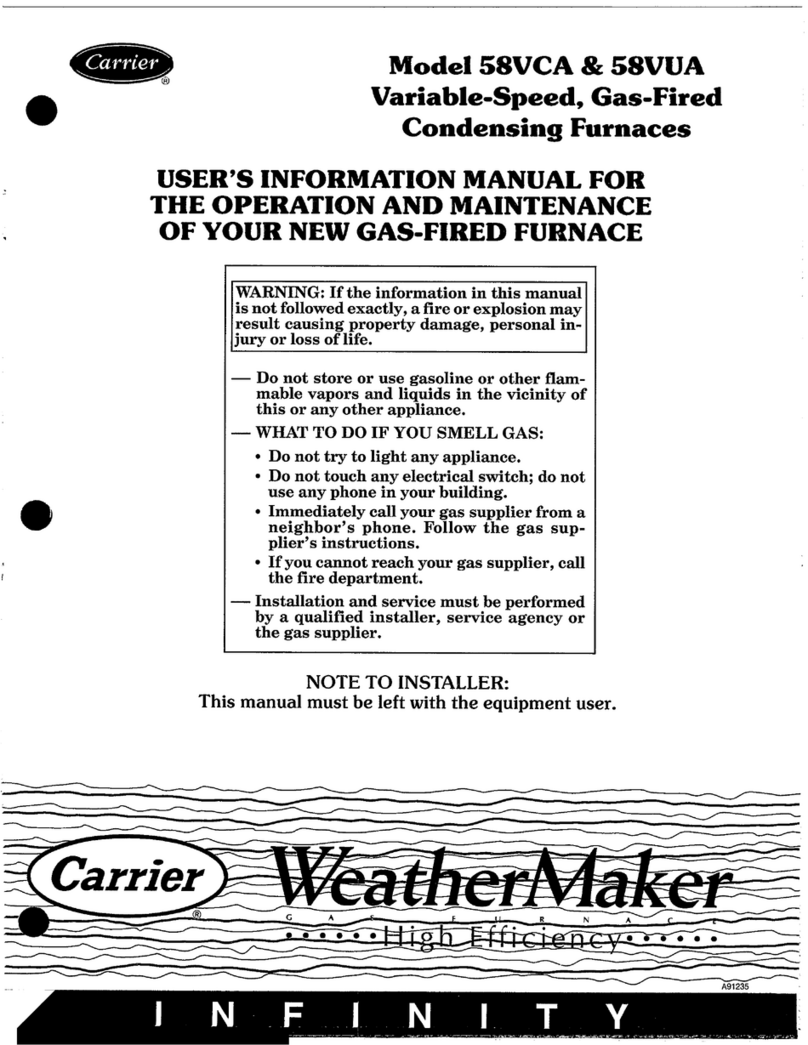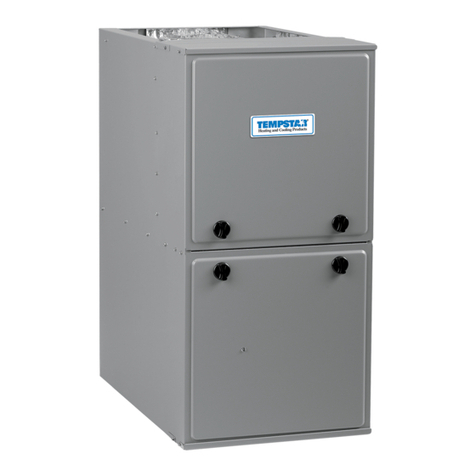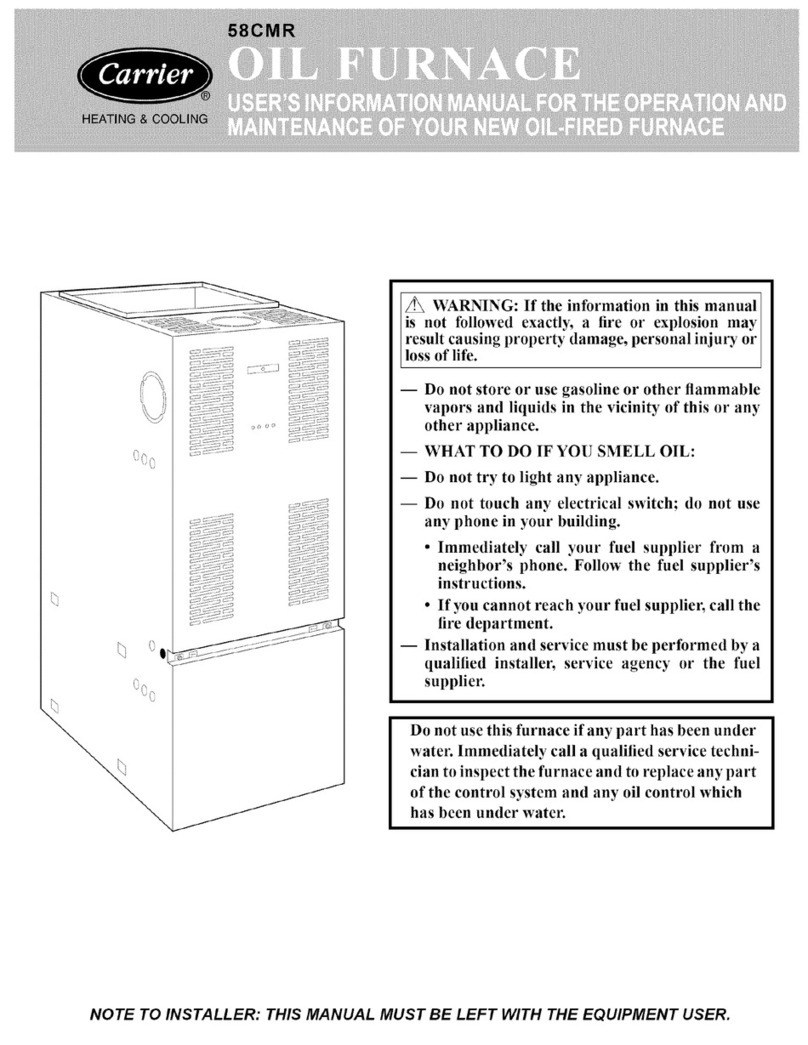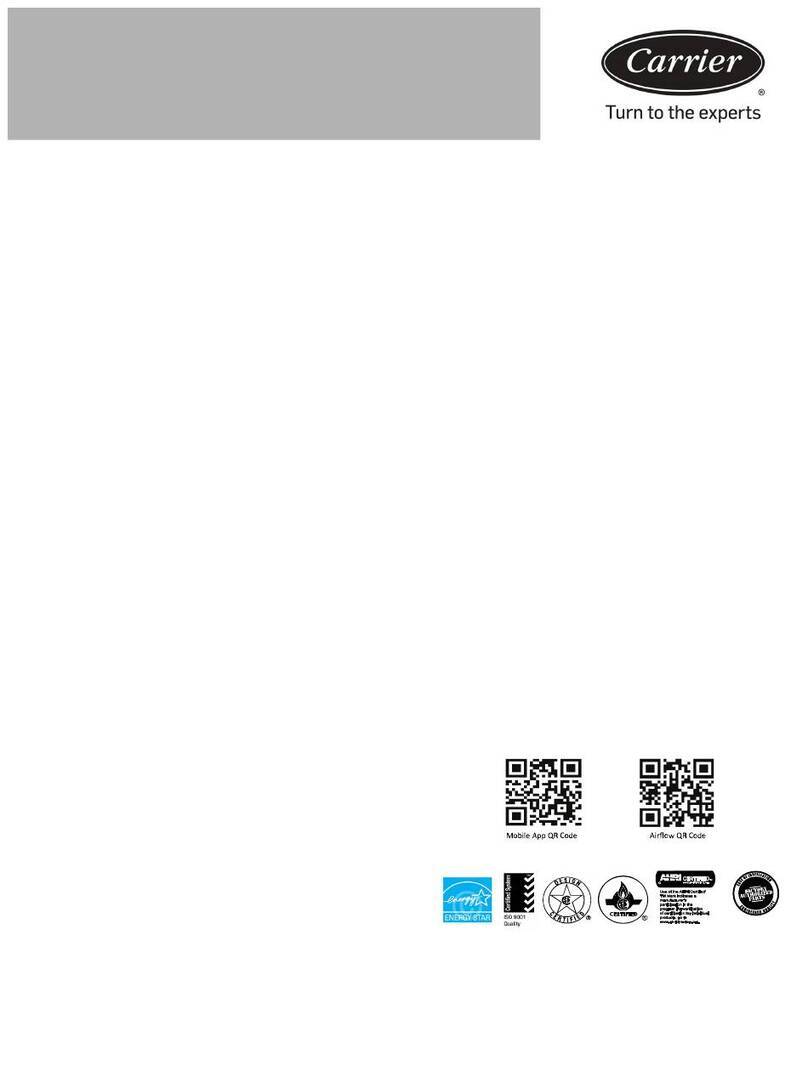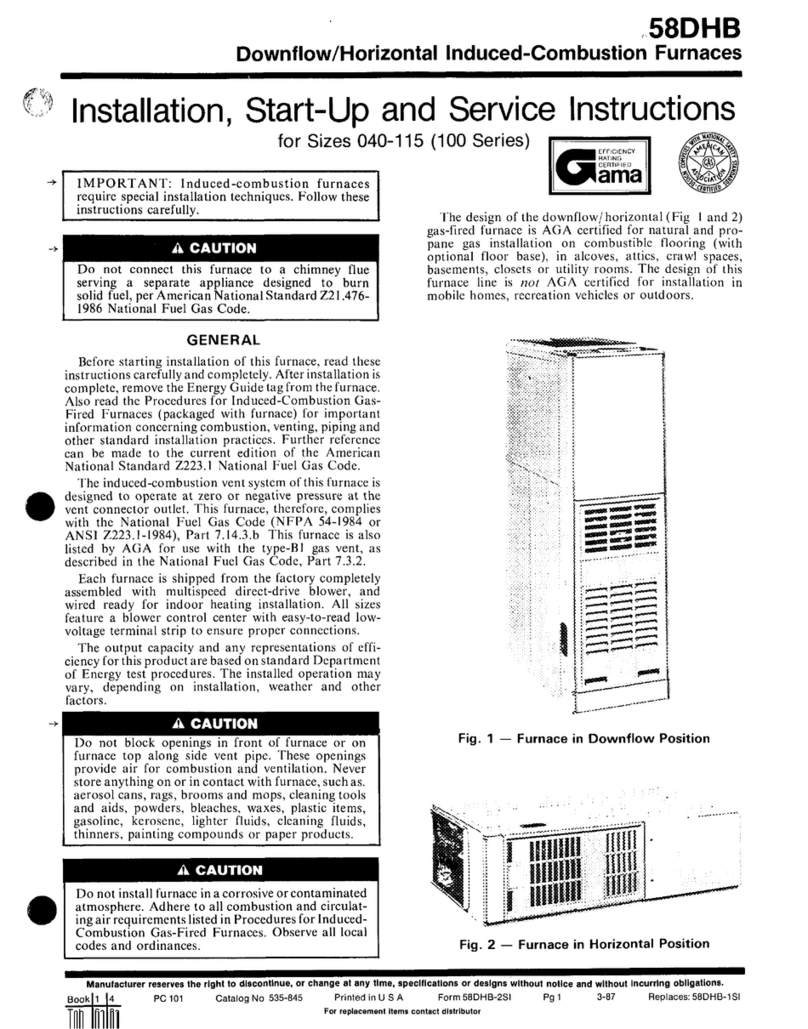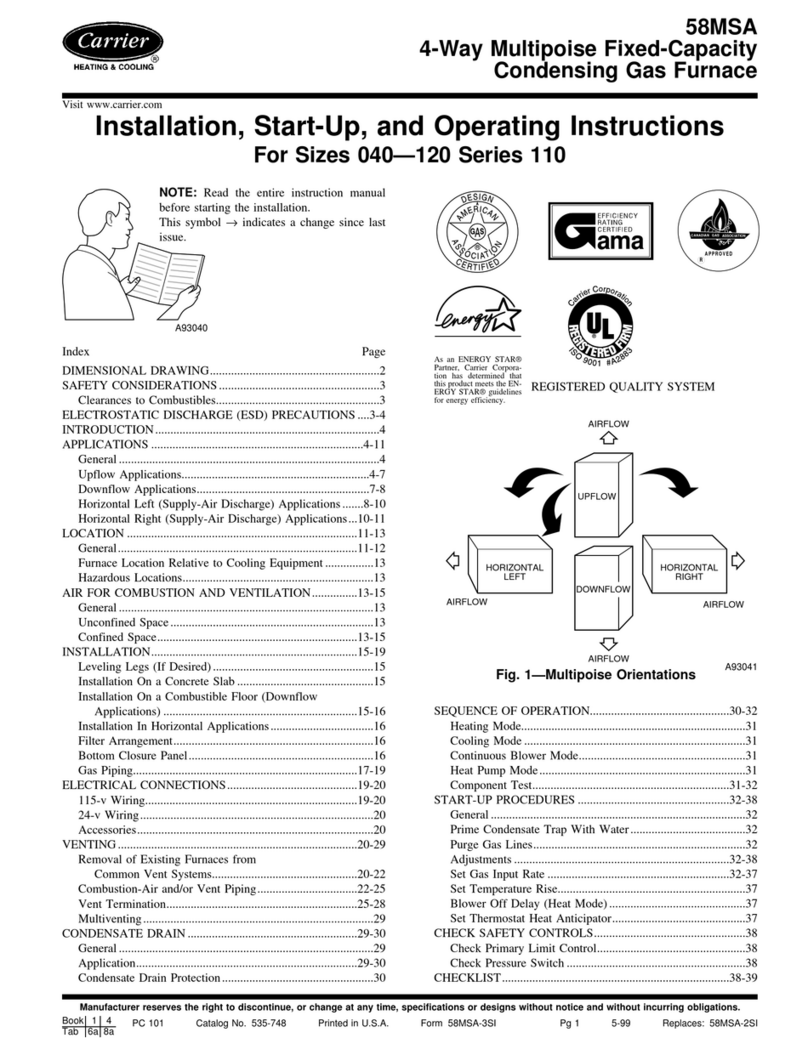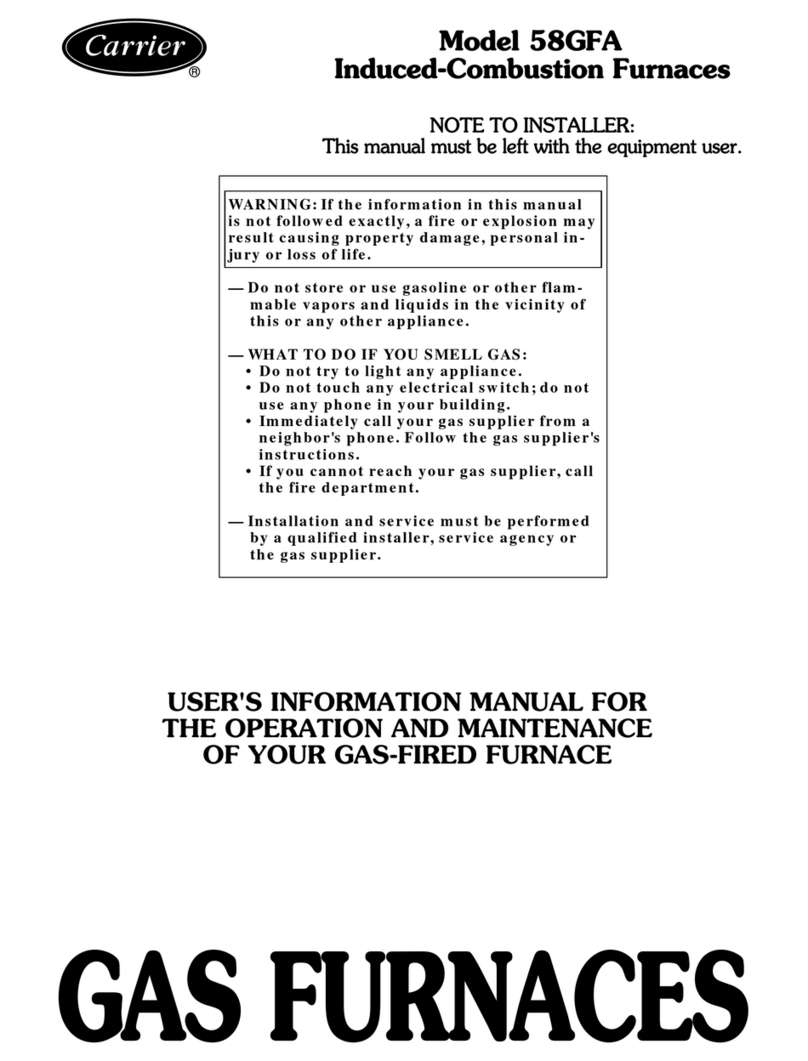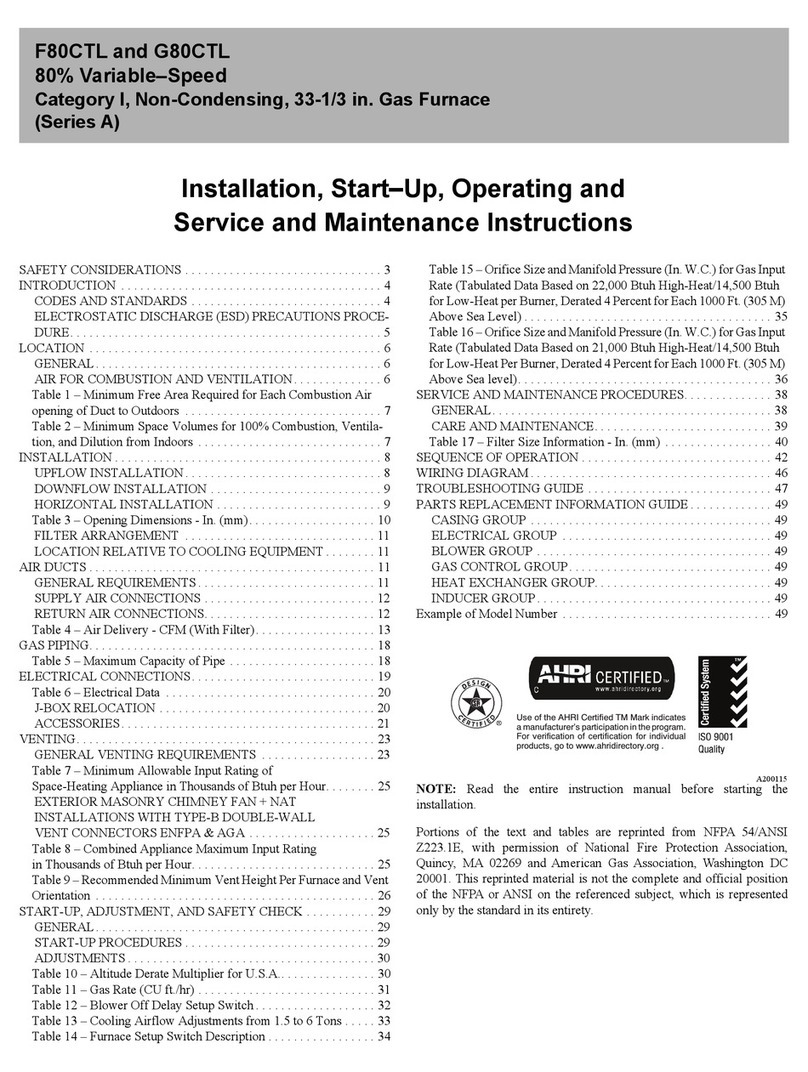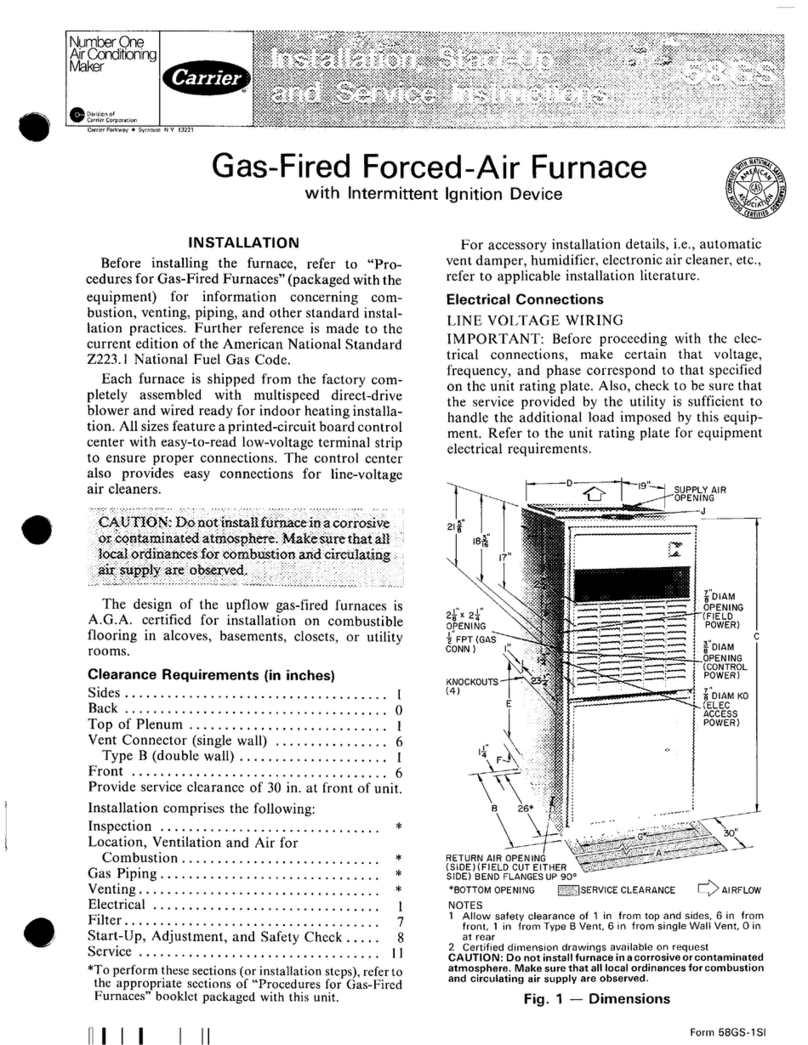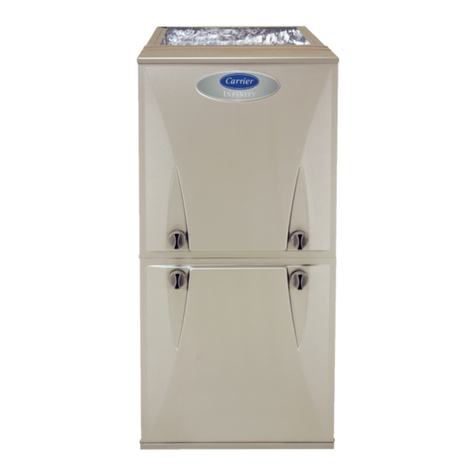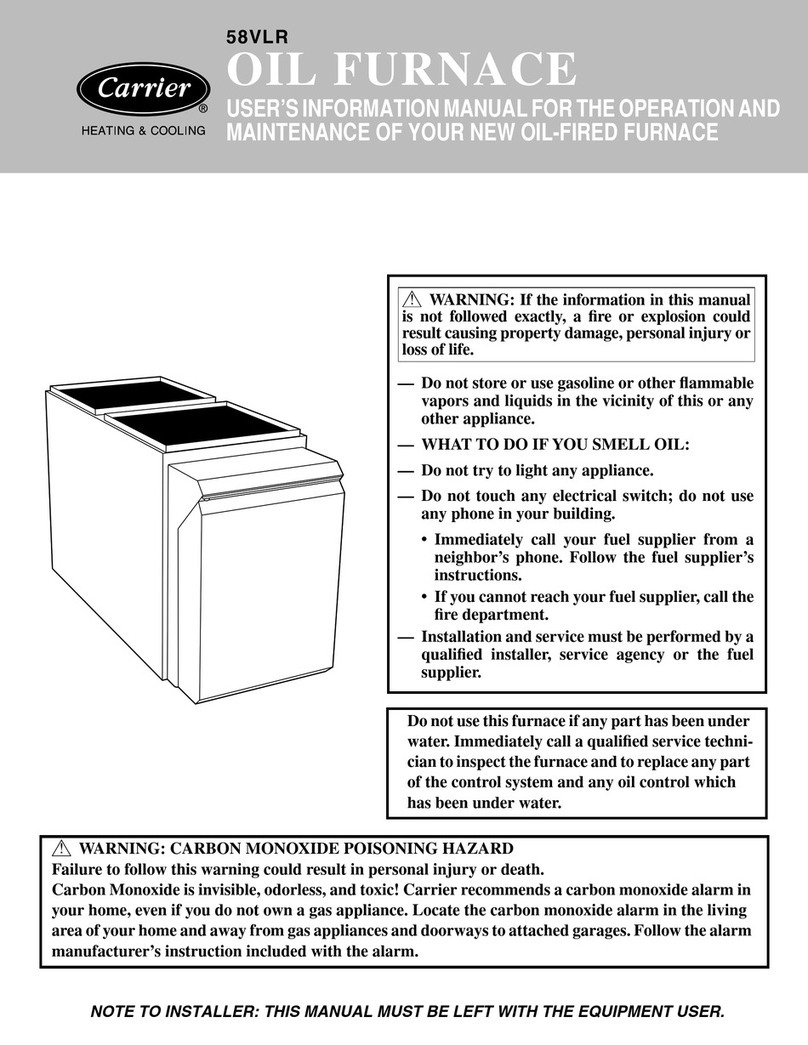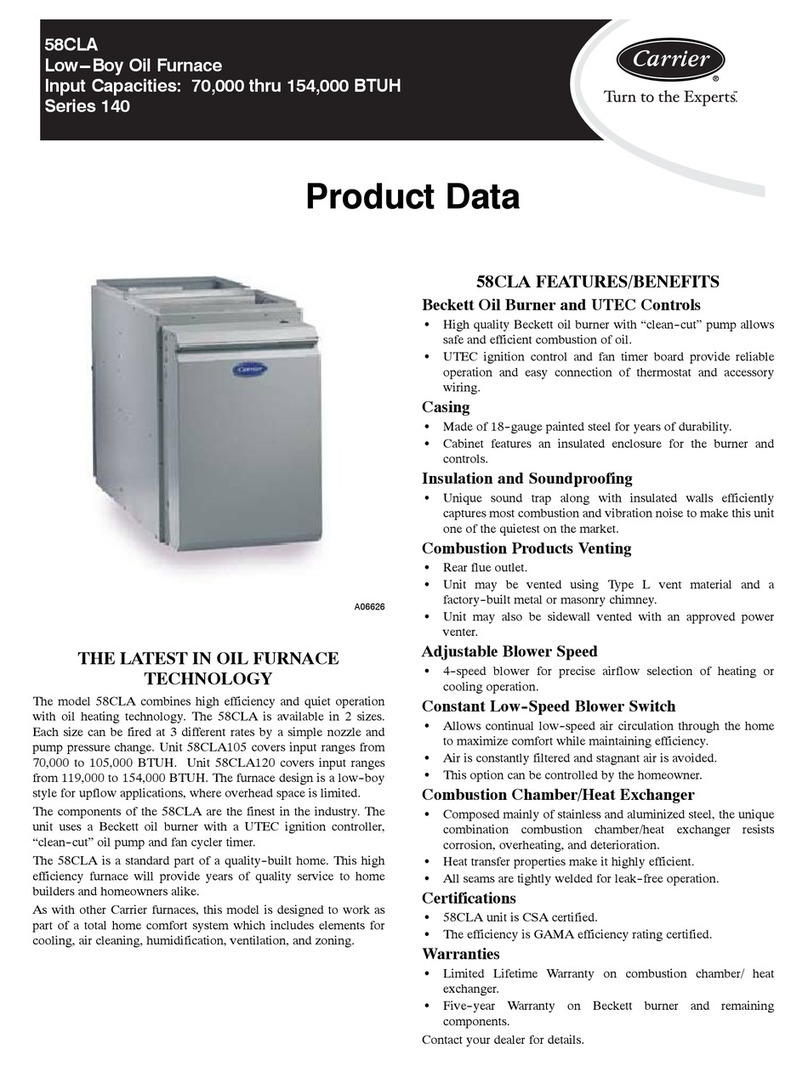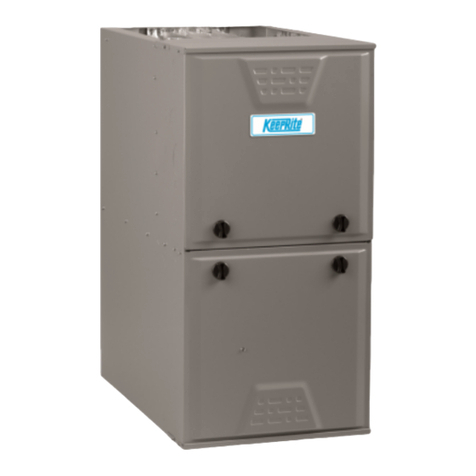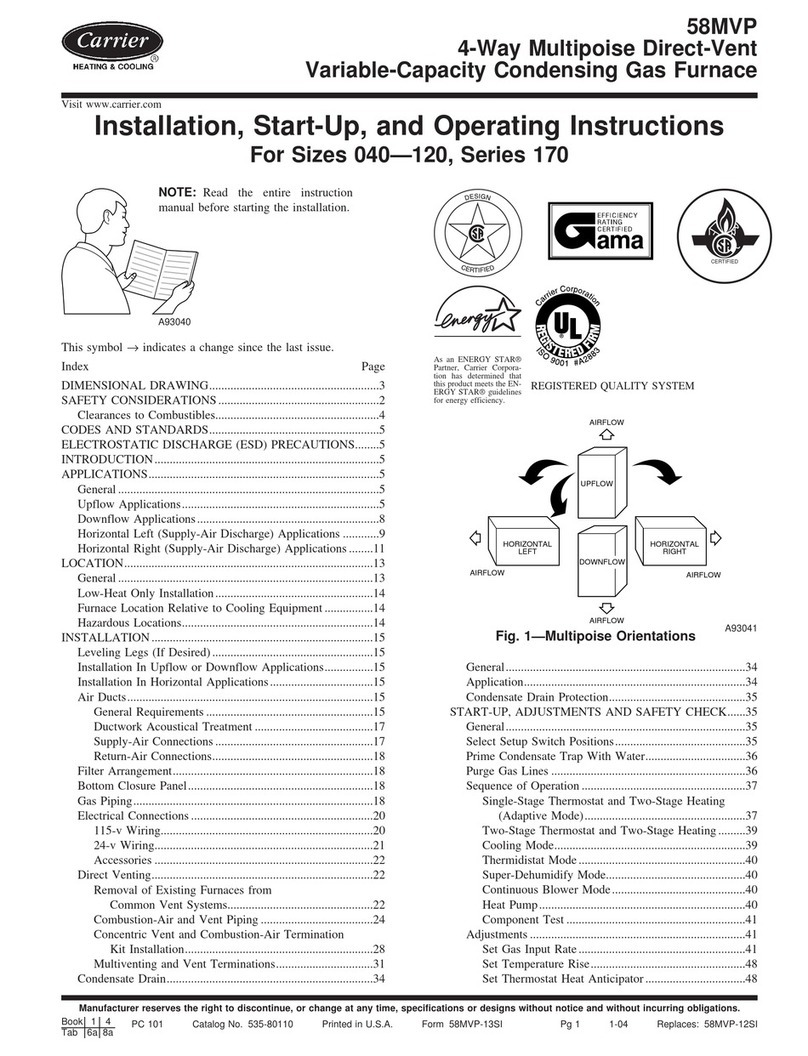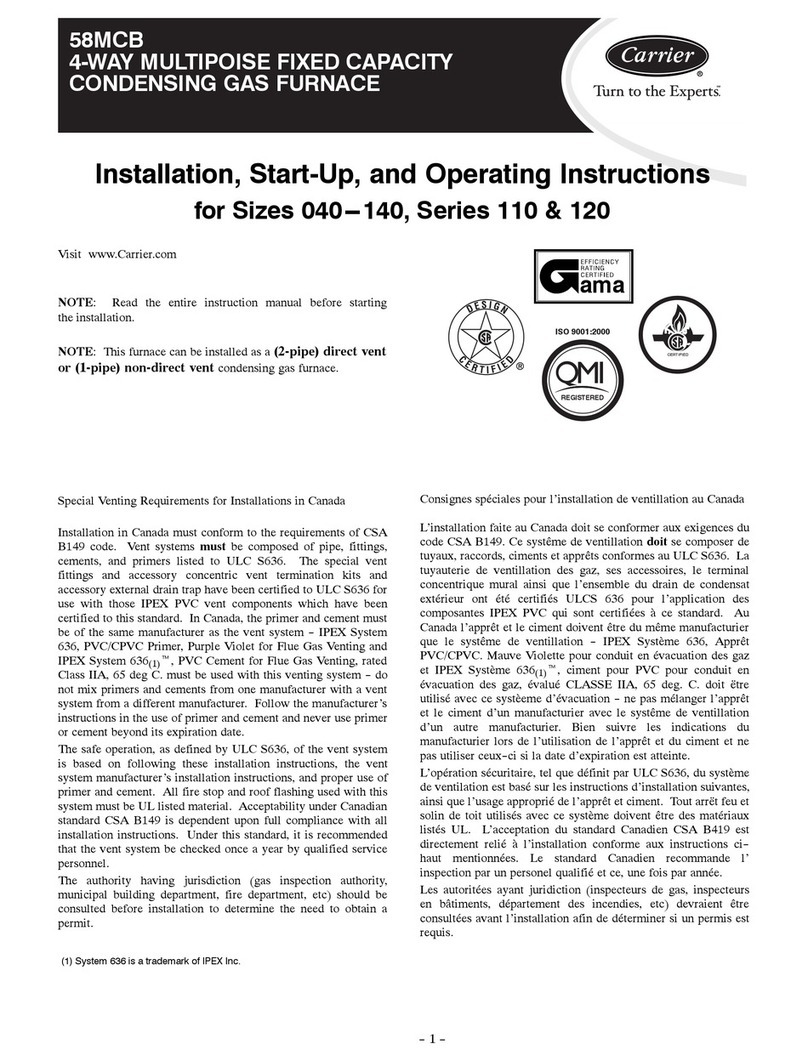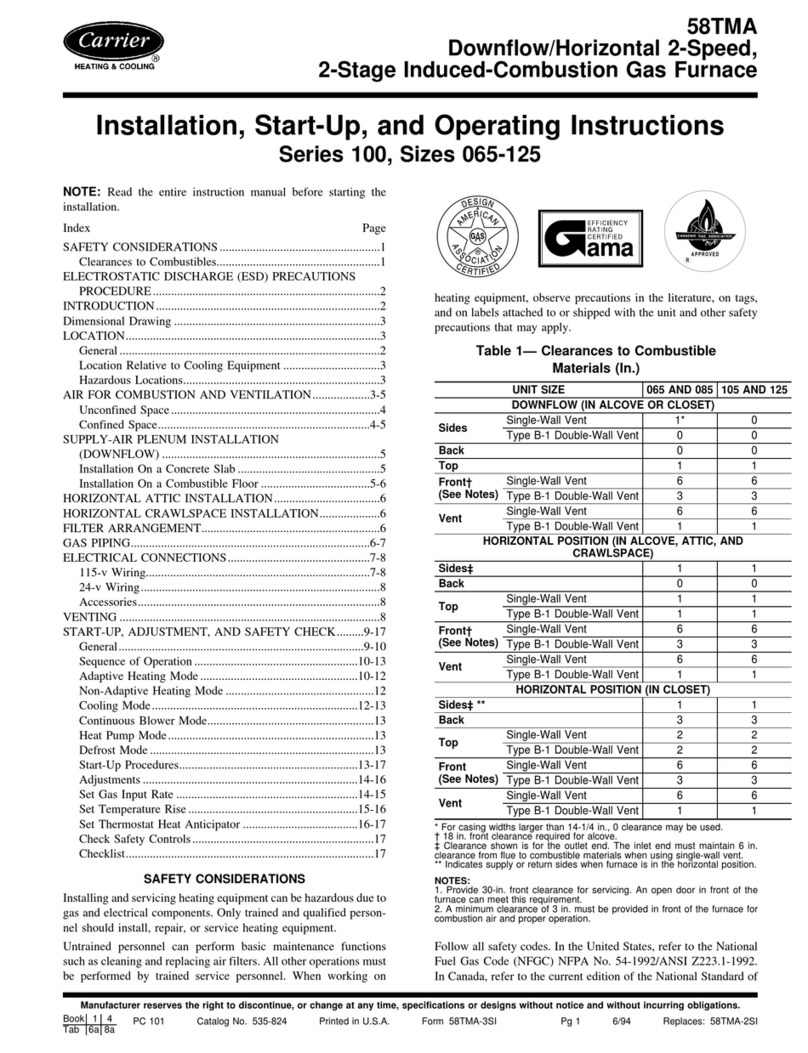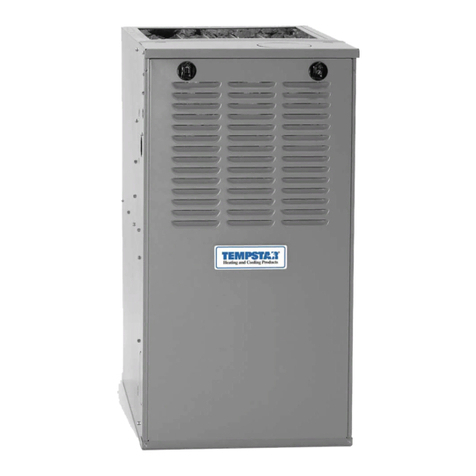
58SU0A (Series 2 & 3): Troubleshooting Guide
Manufacturer reserves the right to change, at any time, specifications and designs without notice and without obligations.
4
GENERAL
The furnace must have a 115-VAC power supply properly connected and
grounded. Correct polarity must be maintained to enable gas heating
operation.
The gas service pressure must not exceed 0.5 psig (14-in. w.c.), and no
less than 0.16 psig (4.5-in. w.c.).
Thermostat wire connections to the furnace at R and W are the minimum
required for gas heating operation. Y is required to be connected to the
furnace for single-stage cooling and heat pumps. G is required for
continuous fan. COM-24V is required for some thermostats. These
connections must be made at the 24-VAC terminal block on the furnace
control. (See Appendix A)
Before operating the furnace, check each manual reset switch for
continuity. If necessary, press and release the button to reset the switch.
SEQUENCE OF OPERATION
Using the schematic diagram in Appendix A, follow the sequence of
operation through the different modes. Read and follow the wiring
diagram very carefully.
NOTE: If a power interruption occurs during a call for heat, the control
will start a 90-second blower-only ON period two seconds after power is
restored if the thermostat is still calling for gas heating. The LED light
will flash code 12 during the 90-second period, after which the LED will
be ON continuous, as long as no faults are detected. After the 90-second
blower-on period, the furnace will respond to the thermostat normally.
The blower access panel must be installed for power to be conducted
through the blower door interlock switch ILK to the furnace control
CPU, transformer TRAN, inducer motor IDM, blower motor BLWM,
hot-surface igniter HSI, and gas valve GV.
1. Heating Mode: The wall thermostat “calls for heat”, closing the
R-W circuit. The furnace control performs a self-check, verifies the
transducer reads no pressure present, and starts the inducer motor
IDM ramp to prepurge pressure
a. Inducer Prepurge Period: The furnace control CPU ramps up
the inducer motor IDM to prepurge pressure then the furnace
control CPU begins a 15-second prepurge period. If the
transducer fails to reach target pressure the inducer motor IDM
will remain running until target pressure is maintained.
b. Igniter Warm-Up: At the end of the prepurge period, the
Hot-Surface Igniter HSI is energized for a 17-second igniter
warm-up period. Inducer maintains pressure during igniter
warm-up.
c. Trial for Ignition: When the igniter warm-up period is
completed the main gas valve relay contact GVR closes to
energize the gas valve solenoid GV. The gas valve solenoid GV
permits gas flow to the burners where it is ignited by the HSI.
Five seconds after the GVR closes, a 2-second flame proving
period begins. The HSI igniter will remain energized until the
flame is sensed or until the 2-second flame proving period
begins.
d. Flame Proving: When the burner flame is proved at the flame
sensor electrode FSE, the inducer motor IDM will increase speed
(after a short delay of 14 seconds on some models) to a higher
RUN pressure. The control will maintain this pressure once
reached, and the furnace control CPU will begin the blower-ON
delay period while continuing to hold the gas valve GV open. If
the burner flame is not proved within the 2-second flame proving
period, the control CPU will open the gas valve relay GVR,
de-energizing the gas valve solenoid GV. The control CPU will
repeat the ignition sequence for up to three more
Trials-For-Ignition before going to an Ignition-Lockout. Lockout
will be reset automatically after three hours, or by momentarily
interrupting 115-VAC power to the furnace, or by interrupting
24-VAC power at SEC1 or SEC2 to the furnace control CPU (not
at W, G, R, etc.). If flame is proved when flame should not be
present, the furnace control CPU will lock out of Heating mode
and operate the inducer motor IDM until flame is no longer
proved.
e. Blower-On-Delay: If the burner flame is proven a 25-second
blower-ON delay begins from when the gas valve GV is opened.
The blower motor BLWM is turned ON at heat airflow.
Simultaneously, the humidifier terminal HUM and electronic air
cleaner terminal EAC-1 are energized and remain energized
throughout the heating cycle.
f. Blower-Off-Delay: When the thermostat is satisfied, the R to W
circuit is opened, de-energizing the gas valve GV, stopping gas
flow to the burners, and de-energizing the humidifier terminal
HUM. The inducer motor IDM will remain energized for a
15-second post-purge period. The blower motor BLWM and air
cleaner terminal EAC-1 will remain energized at heat airflow for
90, 120, 150, or 180 seconds (depending on selection at
blower-OFF delay switches). The furnace control CPU is
factory-set for a 120-second blower-OFF
2. Cooling Mode: The thermostat closes the R-G and -Y circuit for
cooling. The R-Y circuit starts the outdoor unit on cooling speed,
and the R-G and -Y circuit starts the furnace blower motor BLWM
at cooling airflow. Cooling airflow (Table 5) is based on the motor
wire lead selection used on the COOL terminal. The electronic air
cleaner terminal EAC-1 is energized with 115-VAC whenever the
blower motor BLWM is operating. When the thermostat is satisfied,
the R-G and -Y circuit is opened. The outdoor unit stops, and the
furnace blower BLWM and electronic air cleaner terminal EAC-1
will remain energized for an additional 90 seconds. Remove J2
Jumper to reduce the cooling off-delay to 5 seconds.
3. Continuous Blower Mode: When the R-G circuit is closed by the
thermostat, the blower motor BLWM will operate at FAN tap.
Terminal EAC-1 is energized as long as the blower motor BLWM is
energized. During a call for heat, the furnace control CPU will
transition the blower motor BLWM to FAN tap. The blower motor
BLWM will remain ON until the main burners ignite then shut OFF
and remain OFF for 25 seconds before coming back on at HEAT
tap. The blower motor BLWM will revert to FAN tap after the
heating cycle blower off-delay is completed. When the thermostat
“calls for cooling”, the blower motor BLWM will switch to operate
at COOL tap. When the thermostat is satisfied, the blower motor
BLWM will operate an additional 90 seconds at cooling airflow
before transitioning back to FAN tap. When the R-G circuit is
opened, the blower motor BLWM will continue operating for an
additional 5 seconds if no other function requires blower motor
BLWM operation.
4. Heat Pump: When installed with a heat pump, the furnace control
automatically changes the timing sequence to avoid long blower off
times during demand defrost cycles. Whenever the R-W circuit is
closed along with the R-Y circuit, the furnace control CPU will
transition to or bring on the blower motor BLWM at COOL tap.
The blower motor BLWM will remain on until the main burners
ignite then shut OFF and remain OFF for 25 seconds before coming
back on at HEAT tap. When the R-W connection is opened, the
furnace control begins a normal inducer post-purge period while
changing the blower airflow. If R-Y circuit is still closed, the
furnace control CPU will transition the blower motor BLWM
airflow to COOL tap. If R-G circuit is open, the blower motor
BLWM will remain on HEAT tap for the selected blower-OFF
delay period. At the end of the blower-OFF delay, the blower motor
BLWM will shut OFF unless R-G is circuit is closed, in which case
the blower motor BLWM will operate at FAN tap.
